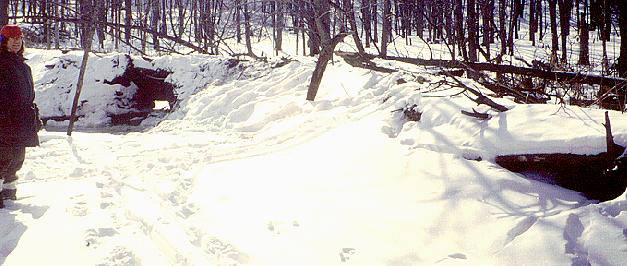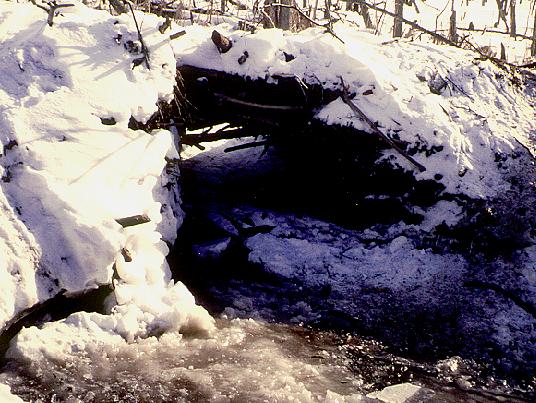

Otters Breaching Beaver Dams
In February 1988, Donald G. Reid, Stephen M. Herrero and Thomas E. Code, three gentlemen at the University of Calgary, published "River Otters as Agents of Water Loss from Beaver Ponds," in the Journal of Mammalogy. They explain in their abstract that they set out to investigate "the contention that, during winter, river otters (Lutra canadensis) lower water levels in ponds created by beavers (Castor canadensis.)" The contention arose from a 1932 paper in which an investigator, Green, saw one instance of the phenomena and reports by trappers that they saw "sudden water loss from beaver ponds during winter coinciding with otters visiting the ponds." In this study the investigators observed beaver pond levels in the Winefred Lake region of northeastern Alberta where there are cold and dry winters with snow covering the ground for an average of 150 days and accumulating on average to a depth of 50cm. For three winters they radio tracked otters that had been trapped and tagged by flying over the area in a Cessna every five days, as well as on foot visually identifying tracks.
From investigating ponds in the spring, they identified several ways beaver ponds lose water in the winter: seepage through holes less than 2 cm in diameter, spill over, channel "with depth not exceeding twice the width", trench with depth over twice the width, tunnel "with height not exceeding twice the width", tunnel-trench or a larger tunnel, and sump or "passage through pond floor." They also looked for and identified any teeth marks at the openings in the dam. (This is what I saw, which got me interested in this phenomena:

The researchers identified a group of control ponds in which otters were not observed. There was a net loss of water in roughly half of those ponds. In ponds where otters were observed, the net water loss was significantly greater. Of 97 ponds observed during winters, only 9 did not have a net loss of water. So they concluded that "ponds to which otters gained access lost water significantly more often than ponds not visited by otters."
The most dramatic lost in the otter-visited ponds was through what the authors called trenches and tunnel-trenches. These holes were "remarkably similar in average width (trenches 31.1 cm; tunnel-trenches 33.5 cm.)" There were also sticks broken off and little lateral erosion. During the study only one otter was observed digging a hole in a dam. "A subadult otter repeatedly submerged its head and upper body at the point of water loss while rear-quarters and tail moved quickly back and forth at the surface." Also on other occasions "sounds resembling chewing and gnawing were heard repeatedly at a site of a water loss." Only at one site could water loss be attributed to beaver activity. While later examination did not reveal otter teeth marking and scratches at tunnels through the dams, almost all the trenches and tunnel-trenches had such markings. Thirteen otters were observed by radio telemetry. Five of them "passed repeatedly through adjacent dams without coming above the ice."
In this study no beavers repaired "sites of water loss" during the winter. Of 178 sites of water loss, beavers repaired 78 when water was opened, and did not repair 68. The rest were partially repaired. The authors suggest that beavers do not repair the holes in the winter "because they cannot receive visual and acoustic stimuli of water loss while swimming under ice with ears closed."
The authors believe that "the primary adaptive value of dam rifting probably lies in the ability of otters to obtain access to water in regions where the water surface freezes on all water bodies." That is, by being able to move through dams under the ice, they are not confined to one pond during the winter or required to travel on the surface of the ponds and find holes into the ice. The successive freezes pond water experiences during the winter can account for why otters dig tunnel-trenches through the dam deeper and deeper. Other advantages the otters gets from rifting beaver dams are: "an increased area for effective foraging because of more extensive air cavities under the ice; an enhanced prey density because of decreased water volume;" and concentration of favored fish both attracted by the current and able to move upstream through the holes.
The authors think that the dams not repaired by beavers were in areas the beavers were abandoning anyway. There may be a mutually beneficial relationship between beavers and otters in dam rifting but "the population dynamics of this relationship need investigation to demonstrate commensalism." The deterioration of habitat caused by dams not being repaired may not matter to otters because of their large ranges.
In the handful of ponds I observed, I have seen three variations on the theme of otters rifting dams: holes made high in the dams to lower water levels just after thick ice forms; huge holes that beavers don't seem to use themselves and which they repair as soon as possible; and huge holes that beavers do use and that they subsequently don't repair even though they stay in the area.
As I analyze the problem, the otters first objective is to lower the water level below the ice as quickly as possible. If once that is done the fish forage runs out, the otters move to another pond. Hence the high holes left in the dam. Indeed, I observed this in rather small ponds. In the ponds I watch, the difference in water levels in adjoining ponds does not necessarily mean that a hole in a dam will allow the otter to swim under the ice directly into the lower pond. But by breaching the dam, the flow from the upper pond to the lower pond can keep a hole in the ice of the lower pond even during long spells of freezing weather. The otter tracks I saw around this dam show the otter coming out of the dam and then onto the ice of the lower pond and diving into the hole in the ice. However, as the winter wears on and hole is dug deeper down into the dam, the otter reaches a level where it can swim from one pond to the next. Otters certainly continue to go up on the dam, a favorite place to scat, even after they breach the dam. In this photo you can see their slides from dam top back into the open water created by the breach.

Beavers can benefit from the holes in the dams. In fact it always seems more of a bother for them to crawl up on the ice than it is for an otter. During one winter, the beavers used the otter hole to increase their range. And they subsequently didn't repair the hole, but instead made a large dam downstream so that enough water remained in the upper pond to still be useful for them. Interestingly, during the next winter the otters got less use out of the pond. While they used the low level upper pond to raise pups and to forage in the fall, they abandoned it when ice formed. I think what they really try to effect is a dramatic fall in water level and that can only be accomplished with a new hole, not the one from the year before.
In some winters I am impressed at how inactive beavers are, but in other winters they seem quite active. One fall after a dry summer the beavers built lodges on or right next to dams. One colony allowed water to flow through the dam at the lodge during the winter thus lowering the water level below the ice. One day I found myself walking on top of the ice near the dam while beavers gnawed on branches directly below me under the ice!
After observing ponds through six winters, I am amazed at how different the ponds can be each winter. Also, certain ponds seem to lend themselves to manipulation and thus exhibit more variations while other ponds seem the same every winter. While I would love to radio track otters, I think a better remote sensor would be one placed in the ponds that can measure the changing conditions during the winter and the activity of mammals and fish as the conditions change
This page is maintained by Bob Arnebeck